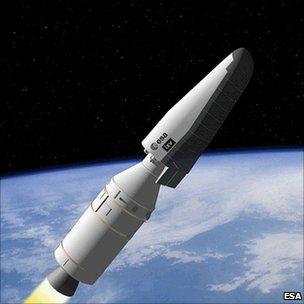High-speed 'space wedge' on track
- Published

The IXV would be launched atop a Vega rocket
The European Space Agency (Esa) is pressing ahead with its re-entry demonstrator known as the IXV, which it expects to launch in 2013.
This distinctive wedge-shaped vehicle will be put at an altitude above 400km from where it will begin its flight back to Earth.
Its suite of sensors should give engineers new insights into how objects fall back through the atmosphere.
Ultimately, the data should inform better spacecraft design.
Even probes sent to land on other worlds like Mars should benefit from the knowledge.
"IXV is providing Europe with important technologies and a step to more ambitious programmes in the future," said Antonio Fabrizi, one of Esa's senior directors.
He signed an agreement at the Paris Air Show that will lead to manufacture of the demonstrator by Thales Alenia Space in Italy.
The company's facility in Turin has spent the past two years researching the concept.
The Intermediate Experimental Vehicle (IXV) is a car-sized, two-tonne automated craft that can be seen as a follow-on to the Advanced Re-entry Demonstrator flown by Esa in 1998.
But whereas ARD was a traditional cone-shaped object, IXV is very different; it has flaps and thrusters to control its descent trajectory. A ceramic heatshield on its underside will prevent IXV from burning up.
The vehicle will launch from French Guiana in South America on Esa's forthcoming small rocket, Vega.
The top stage of Vega will put IXV on a sub-orbital trajectory around the Earth that will bring the demonstrator down in Pacific. A parachute will be deployed to bring it to a gentle splash-down. The whole mission should last about an hour.
The knowledge gained from the flight is expected to feed into materials research and the computer models that are used to describe the energetic physics that occurs when an object plunges through atmospheric gases at several kilometres per second.
Europe's expertise on re-entry technologies is more limited than, say, the US, and it is looking to boost its knowledge with a number of flight demos.
Next year, Esa will also launch its EXPERT (eXPErimental Reentry Testbed) vehicle.
This is smaller than the IXV at just over 1.5m in length and weighing slightly less than 450kg; but again, it will be packed with sensors.
EXPERT will launch to just over 100km on a submarine missile before falling back to the ground and landing by parachute.
Thales Alenia Space is also leading this project industrially, too.
"We are growing a competency in re-entry in our company and this will feed into future missions," Luigi Pasquali, the president and CEO of Thales Alenia Space (Italy), told BBC News.
Although only one flight of the IXV is currently planned, its recovery from the ocean would allow further experimental flights to be conducted.